您好,登錄后才能下訂單哦!
您好,登錄后才能下訂單哦!
本篇內容介紹了“IOS程序員必須知道的Android要點有哪些”的有關知識,在實際案例的操作過程中,不少人都會遇到這樣的困境,接下來就讓小編帶領大家學習一下如何處理這些情況吧!希望大家仔細閱讀,能夠學有所成!
UI設計簡要說明
本文不 會深入研究關于IOS和Android兩個平臺之間的用戶體驗或者設計模式之間的差異,不過如果能夠理解Android上的一些優秀的UI范例也很有幫 助:ActionBar、Overflow menu、back button share action等等。假如你很想嘗試Android開發,那么強烈推薦你去Google Play Store上購置一臺Nexus5,然后把它作為你日常使用的設備使用一周,然后嘗試仔細了解這個操作系統的各種功能和擴展特性,如果開發者連操作系統的 各種使用規則都不了解,那么做出來的產品一定有問題。
編程語言的應用框架
Objective-C和Java之間有很多不同之處,如果把Objective-C的編程風格帶到Java里面的話,很多代碼也許會和底層的應用框架沖突。簡單地說,就是需要注意一些區別:
去掉Objective-C里面的類前綴,因為Java里有顯式的命名空間和包結構,所以就沒必要用類前綴了。
實例變量的前綴用“m”,不用“_”,在寫代碼的過程中要多利用JavaDoc文檔。這樣能使代碼更清晰,更適合團隊合作。
注意檢查NULL值,Objective-C對空值檢查做的很好,不過Java沒有。
不直接使用屬性,如果需要setter和getter,需要創建一個getVariableName()方法,然后顯式調用它。如果直接使用“this.object”不會調用自定義的getter方法,你必須使用this.getObject這樣的方法。
同樣的,方法命名時帶有get和set前綴來標示它是getter和setter方法,Java的方法很喜歡寫成actions或者queries等,比如Java會使用getCell(),而不用cellForRowAtIndexPath。
項目結構
Android 應用程序主要分為兩部分。***部分是Java源代碼,以Java包結構排布,也可以根據自己的喜好進行結構排布。最基本的結構就是分為這幾個頂層目 錄:activities、fragments、views、adapters和data(models和managers)。
第 二部分是res文件夾,就是“resource”的簡稱,res目錄存放的是圖片、xml布局文件,還有其它xml值文件,是非代碼資源的一部分。在 IOS上,圖片只需要匹配兩個尺寸,而在Android上有很多種屏幕尺寸需要考慮,Android上用文件夾來管理管理圖片、字符串,還有其它的屏幕配 置數值等。res文件夾里也含有類似IOS中xib文件的xml文件,還有存儲字符串資源、整數值,以及樣式的xml文件。
***,在項目結構上還有一點相似的地方,就是AndroidManifest.xml文件。這個文件相當于IOS的Project-Info.plist文 件,它存儲了activities、application還有Intent的信息,要了解更多關于Intent的資料,可以繼續閱讀這篇文章。
Activities
Activities 是Android APP最基本的可視單元,就像UIViewControllers是IOS最基本的顯示組件一樣。Android系統使用一個Activity棧來管理 Activity,而IOS使用UINavigationController進行管理。當APP啟動的時候,Android系統會把Main Activity壓棧,值得注意的是這是還可以再運行別的APP Activity,然后把它放到Activity棧中。返回鍵默認會從Activity棧進行pop操作,所以如果用戶按下返回鍵,就可以切換運行已運行 的App了。
Activities還可以用Intent組件初始化別的Activity,初始化時 可攜帶數據。啟動一個新的Activity類似于IOS上創建一個UIViewController。最基本的啟動一個新的Activity的方式就是創 建一個帶有data的Intent組件。Android上實現自定義Intent初始化器的***方法就是寫一個靜態getter方法。在Activity 結束的時候也可以返回數據,在Activity結束的時候可以往Intent里面放置額外的數據。
IOS 和Android的一個大的區別是,任何一個在AndroidManifest文件中注冊的Activity都可以作為程序的入口,為Activity設 置一個intent filter屬性比如“media intent”,就可以處理系統的媒體文件了。***的例子就是編輯照片Activity。它可以打開一張照片,然后進行修改,***在Activity結束 時返回修改后的照片。
附加提醒:要想在Activity和Fragment之間傳遞對象,必須要實 現Parcelable接口,就像在IOS里需要遵循協議一樣。還有,Parcelable對象可以存在于Activity或者Fragment的 savedInstanceState里,這樣在它們被銷毀后可以更容易重建它們的狀態。
下面就來看看怎么在一個Activity中啟動另一個Activity,然后在第二個Activity結束時進行返回。
啟動其它Activity并返回結果
// A request code is a unique value for returning activities private static final int REQUEST_CODE_NEXT_ACTIVITY = 1234; protected void startNextActivity() { // Intents need a context, so give this current activity as the context Intent nextActivityIntent = new Intent(this, NextActivity.class); startActivityForResult(nextActivityResult, REQUEST_CODE_NEXT_ACTIVITY); } @Override protected void onActivityResult(int requestCode, int resultCode, Intent data) { switch (requestCode) { case REQUEST_CODE_NEXT_ACTIVITY: if (resultCode == RESULT_OK) { // This means our Activity returned successfully. For now, Toast this text. // This just creates a simple pop-up message on the screen. Toast.makeText(this, "Result OK!", Toast.LENGTH_SHORT).show(); } return; } super.onActivityResult(requestCode, resultCode, data); }Fragment 的概念在Android上比較獨特,從Android3.0開始引入。Fragment是一個迷你版的控制器,可以顯示在Activity上。它有自己的 狀態和邏輯,同時在一個屏幕上支持多個Fragment同時顯示。Activity充當Fragment的控制器,Fragment沒有自己的上下文環 境,只能依賴Activity存在。
使用Fragment***的例子就是在平板上的應用。可以在屏幕左邊放一個fragment列表,然后在屏幕的右邊放fragment的詳細信息。Fragment可以把屏幕分成可重復利用的小塊,分別控制管理。不過要注意Fragment的生命周期,會有些細微的差別。
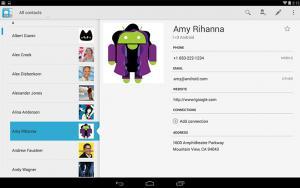
Fragment 是實現Android結構化的一種新的方式,就像IOS中的不用UITableview而用UICollectionView實現列表數據結構化。因為只 使用Activity而不用Fragment的話,會簡單一些。不過,之后你會遇到麻煩。如果不使用Fragment代替全盤使用Activity的話, 在后面需要利用intent和進行多屏幕支持的時候就會遇到困難。
下面看一個UITableViewController的例子和一個ListFragment的地鐵時刻表示例。
表格實現
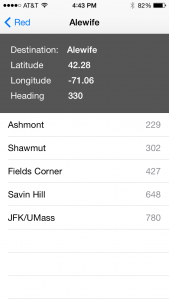
@interface MBTASubwayTripTableTableViewController () @property (assign, nonatomic) MBTATrip *trip; @end @implementation MBTASubwayTripTableTableViewController -(instancetype)initWithTrip:(MBTATrip *)trip { self = [super initWithStyle:UITableViewStylePlain]; if (self) { _trip = trip; [self setTitle:trip.destination]; } return self; } -(void)viewDidLoad { [super viewDidLoad]; [self.tableView registerClass:[MBTAPredictionCell class] forCellReuseIdentifier:[MBTAPredictionCell reuseId]]; [self.tableView registerNib:[UINib nibWithNibName:NSStringFromClass([MBTATripHeaderView class]) bundle:nil] forHeaderFooterViewReuseIdentifier:[MBTATripHeaderView reuseId]]; } #pragma mark - UITableViewDataSource -(NSInteger)numberOfSectionsInTableView:(UITableView *)tableView { return 1; } -(NSInteger)tableView:(UITableView *)tableView numberOfRowsInSection:(NSInteger)section { return [self.trip.predictions count]; } #pragma mark - UITableViewDelegate -(CGFloat)tableView:(UITableView *)tableView heightForHeaderInSection:(NSInteger)section { return [MBTATripHeaderView heightWithTrip:self.trip]; } -(UIView *)tableView:(UITableView *)tableView viewForHeaderInSection:(NSInteger)section { MBTATripHeaderView *headerView = [self.tableView dequeueReusableHeaderFooterViewWithIdentifier:[MBTATripHeaderView reuseId]]; [headerView setFromTrip:self.trip]; return headerView; } -(UITableViewCell *)tableView:(UITableView *)tableView cellForRowAtIndexPath:(NSIndexPath *)indexPath { UITableViewCell *cell = [tableView dequeueReusableCellWithIdentifier:[MBTAPredictionCell reuseId] forIndexPath:indexPath]; MBTAPrediction *prediction = [self.trip.predictions objectAtIndex:indexPath.row]; [(MBTAPredictionCell *)cell setFromPrediction:prediction]; return cell; } -(BOOL)tableView:(UITableView *)tableView canEditRowAtIndexPath:(NSIndexPath *)indexPath { return NO; } - (void)tableView:(UITableView *)tableView didSelectRowAtIndexPath:(NSIndexPath *)indexPath { [tableView deselectRowAtIndexPath:indexPath animated:YES]; } @endList Fragment實現

public class TripDetailFragment extends ListFragment { /** * The configuration flags for the Trip Detail Fragment. */ public static final class TripDetailFragmentState { public static final String KEY_FRAGMENT_TRIP_DETAIL = "KEY_FRAGMENT_TRIP_DETAIL"; } protected Trip mTrip; /** * Use this factory method to create a new instance of * this fragment using the provided parameters. * * @param trip the trip to show details * @return A new instance of fragment TripDetailFragment. */ public static TripDetailFragment newInstance(Trip trip) { TripDetailFragment fragment = new TripDetailFragment(); Bundle args = new Bundle(); args.putParcelable(TripDetailFragmentState.KEY_FRAGMENT_TRIP_DETAIL, trip); fragment.setArguments(args); return fragment; } public TripDetailFragment() { } @Override public View onCreateView(LayoutInflater inflater, ViewGroup container, Bundle savedInstanceState) { Prediction[] predictions= mTrip.predictions.toArray(new Prediction[mTrip.predictions.size()]); PredictionArrayAdapter predictionArrayAdapter = new PredictionArrayAdapter(getActivity(), predictions); setListAdapter(predictionArrayAdapter); return super.onCreateView(inflater,container, savedInstanceState); } @Override public void onViewCreated(View view, Bundle savedInstanceState) { super.onViewCreated(view, savedInstanceState); TripDetailsView headerView = new TripDetailsView(getActivity()); headerView.updateFromTripObject(mTrip); getListView().addHeaderView(headerView); } }下面,我們來分析Android上特有的一些組件。
Android通用組件
ListView和Adapter
ListView 和IOS的UITableView最像,也是使用最頻繁的組件之一。類似于UITableView的 UITableViewController,ListView也有一個ListActivity,還有ListFragment。這些組件會更好地處理 一些布局問題,也為操作數據適配器提供了便利,這個接下來會說到。下面這個例子就是使用ListFragment來展示數據,類似TableView的 datasource。
關于datasource,Android上沒有datasource和 delegate,只有Adapter。Adapter有很多種形式,主要功能其實就是為了把datasource和delegate合在一起。 Adapter拿到數據然后填充到Listview中,在ListView中初始化響應的組件并顯示出來,下面是arrayAdapter的使用:
public class PredictionArrayAdapter extends ArrayAdapter { int LAYOUT_RESOURCE_ID = R.layout.view_three_item_list_view; public PredictionArrayAdapter(Context context) { super(context, R.layout.view_three_item_list_view); } public PredictionArrayAdapter(Context context, Prediction[] objects) { super(context, R.layout.view_three_item_list_view, objects); } @Override public View getView(int position, View convertView, ViewGroup parent) { Prediction prediction = this.getItem(position); View inflatedView = convertView; if(convertView==null) { LayoutInflater inflater = (LayoutInflater)getContext().getSystemService(Context.LAYOUT_INFLATER_SERVICE); inflatedView = inflater.inflate(LAYOUT_RESOURCE_ID, parent, false); } TextView stopNameTextView = (TextView)inflatedView.findViewById(R.id.view_three_item_list_view_left_text_view); TextView middleTextView = (TextView)inflatedView.findViewById(R.id.view_three_item_list_view_middle_text_view); TextView stopSecondsTextView = (TextView)inflatedView.findViewById(R.id.view_three_item_list_view_right_text_view); stopNameTextView.setText(prediction.stopName); middleTextView.setText(""); stopSecondsTextView.setText(prediction.stopSeconds.toString()); return inflatedView; } }可 以看到,adapter里面有一個很重要的方法叫getView,和IOS的cellForRowAtIndexPath方法一樣。還有一個相似之處就是 循環利用的策略,和IOS6上的實現很相似。在Android和IOS上循環利用View都很重要,事實上它對列表的實現有很大幫助。這個adapter 很簡單,使用了一個內建的類ArrayAdapter來存放數據,也解釋了怎么把數據填入ListView中。
AsyncTask
對于IOS上的Grand Central Dispatch,Android上也有AsyncTask。它是異步操作工具的又一選擇,用一種很友好的方式實現異步任務。不過AsyncTask有點超出了本文的范圍,所以本人還是推薦你看看這里。
Activity的生命周期
IOS開發者在寫Android的過程中還要注意的就是Android的生命周期。可以先從Activity的生命周期文檔開始:
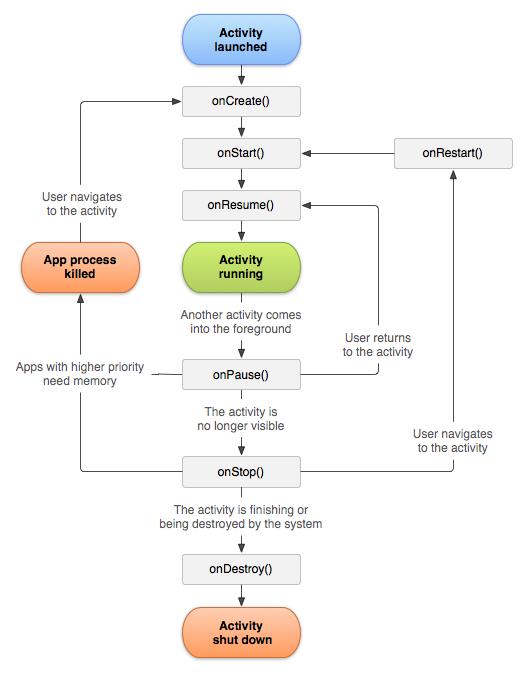
本 質上Activity的生命周期很像UIViewController的生命周期,主要區別在于Android上可以任意銷毀Activity,所以保證 Activity的數據和狀態很重要,如果在onCreate()中保存了的話,可以在saved state中恢復Activity的狀態。***的方法就是使用saveInstanceState來存儲bundled數據,例如下面的 TripListActivity是示例工程的一部分,用來保存當前顯示的數據:
public static Intent getTripListActivityIntent(Context context, TripList.LineType lineType) { Intent intent = new Intent(context, TripListActivity.class); intent.putExtra(TripListActivityState.KEY_ACTIVITY_TRIP_LIST_LINE_TYPE, lineType.getLineName()); return intent; } public static final class TripListActivityState { public static final String KEY_ACTIVITY_TRIP_LIST_LINE_TYPE = "KEY_ACTIVITY_TRIP_LIST_LINE_TYPE"; } TripList.LineType mLineType; @Override protected void onCreate(Bundle savedInstanceState) { super.onCreate(savedInstanceState); mLineType = TripList.LineType.getLineType(getIntent().getStringExtra(TripListActivityState.KEY_ACTIVITY_TRIP_LIST_LINE_TYPE)); }還 有一個要注意的地方就是屏幕旋轉:如果屏幕發生旋轉,會改變Activity的生命周期。也就是說,Activity會先被銷毀,然后再重建。如果已經保 存了數據和狀態,Activity可以重建原來的狀態,實現無縫重建。很多APP開發者在遇到APP旋轉時會出現問題,因為Activity沒有處理旋轉 的改變。注意不要用鎖定屏幕的方向來解決這個問題,因為這樣會存在一個隱含的生命周期的bug,在某些情況下還是可能發生的。
Fragment生命周期
Fragment的生命周期和Activity的很像,但是有一些區別:
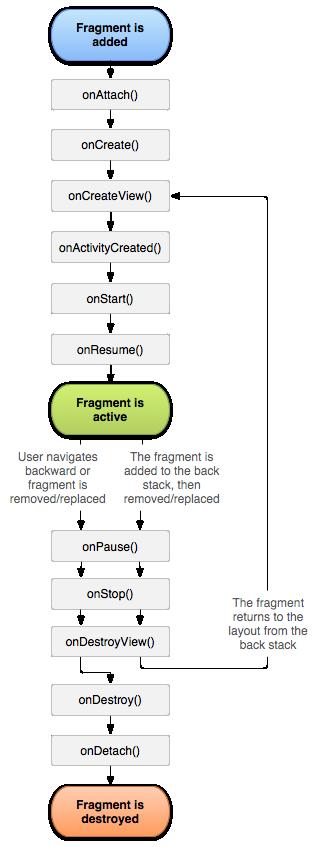
還 有一個問題就是Fragment和Activity通信的問題。需要注意的是onAttach()方法在onActivityCreated()方法之前 被調用,這就意味著在fragment創建完成后Activity還不能保證已經存在。如果需要為父Activity設置接口或者代理,則需要在 onActivityCreated()方法調用之后。
Fragment也有可能會在系統需要的時候被創建和銷毀。如果要保存它的狀態,那么也要像Activity一樣進行處理。下面這個是示例項目中的一個小例子,trip列表Fragment會記錄相應的數據,和上面的地鐵時間示例一樣:
/** * The configuration flags for the Trip List Fragment. */ public static final class TripListFragmentState { public static final String KEY_FRAGMENT_TRIP_LIST_LINE_TYPE = "KEY_FRAGMENT_TRIP_LIST_LINE_TYPE"; public static final String KEY_FRAGMENT_TRIP_LIST_DATA = "KEY_FRAGMENT_TRIP_LIST_DATA"; } /** * Use this factory method to create a new instance of * this fragment using the provided parameters. * * @param lineType the subway line to show trips for. * @return A new instance of fragment TripListFragment. */ public static TripListFragment newInstance(TripList.LineType lineType) { TripListFragment fragment = new TripListFragment(); Bundle args = new Bundle(); args.putString(TripListFragmentState.KEY_FRAGMENT_TRIP_LIST_LINE_TYPE, lineType.getLineName()); fragment.setArguments(args); return fragment; } protected TripList mTripList; protected void setTripList(TripList tripList) { Bundle arguments = this.getArguments(); arguments.putParcelable(TripListFragmentState.KEY_FRAGMENT_TRIP_LIST_DATA, tripList); mTripList = tripList; if (mTripArrayAdapter != null) { mTripArrayAdapter.clear(); mTripArrayAdapter.addAll(mTripList.trips); } } @Override public void onCreate(Bundle savedInstanceState) { super.onCreate(savedInstanceState); if (getArguments() != null) { mLineType = TripList.LineType.getLineType(getArguments().getString(TripListFragmentState.KEY_FRAGMENT_TRIP_LIST_LINE_TYPE)); mTripList = getArguments().getParcelable(TripListFragmentState.KEY_FRAGMENT_TRIP_LIST_DATA); } }還 要注意的是,Fragment經常會在onCreate方法中利用bundled參數重建自己的狀態。而自定義的Trip列表模型類相關的setter方 法也會把對象添加到bundled參數中。這樣就可以保證在Fragment被銷毀或者重建時,比如屏幕旋轉后,可以利用***的數據去重建狀態。
關于布局
和Android上其它部分的開發工作一樣,指定布局文件也有自己的優缺點。Android上的布局文件都存放在res/layouts文件夾中,以易讀的xml形式存儲。
地鐵列表布局
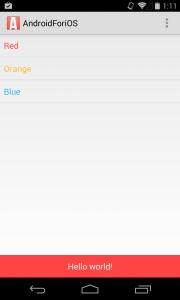
xmlns:tools="http://schemas.android.com/tools" android:layout_width="match_parent" android:layout_height="match_parent" tools:context="com.example.androidforios.app.activities.MainActivity$PlaceholderFragment"> android:id="@+id/fragment_subway_list_listview" android:layout_width="match_parent" android:layout_height="match_parent" android:paddingBottom="@dimen/Button.Default.Height"/> android:id="@+id/fragment_subway_list_Button" android:layout_width="match_parent" android:layout_height="@dimen/Button.Default.Height" android:minHeight="@dimen/Button.Default.Height" android:background="@drawable/button_red_selector" android:text="@string/hello_world" android:textColor="@color/Button.Text" android:layout_alignParentBottom="true" android:gravity="center"/>
下面這個是IOS上用UITableView和UIButton來制作的類似效果:
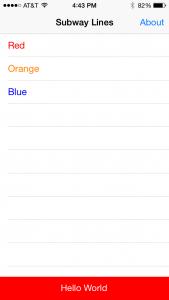
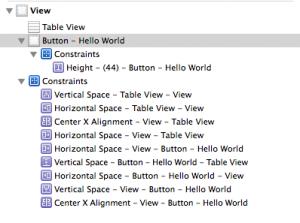
可以發現,Android的布局文件更容易閱讀和理解,而且提供了多種布局方式,我們只介紹了其中的一小部分。
通常來說,我們接觸的最基本的UI結構就是ViewGroup的子類,RelativeLayout、LinearLayout、FrameLayout是最常用的。這些ViewGroup的子類可以容納別的View,并包含了一些排布控件的屬性。
一個很好的例子就是上面用到的RelativeLayout,在里面可以使用android:layout_alignParentBottom="true"來把按鈕定位到布局底部。
***,如果要在Fragment或者Activity中使用這些控件的話,可以在onCreateView()方法中使用布局的資源ID:
@Override public View onCreateView(LayoutInflater inflater, ViewGroup container, Bundle savedInstanceState) { return inflater.inflate(R.layout.fragment_subway_listview, container, false); }布局小貼士
請使用dp(density-independent pixels),不直接使用dx(pixels);
不要在可視化編輯器中移動布局組件——通常來說可視化編輯器在你調好高和寬后,會為組件添加一些多余的像素,所以***就是直接操作xml文件;
如果在布局的height和width看到有用fill_parent這個屬性的話,你會發現在API 8的時候這個屬性就已經被限制了,改用match_parent替換。
如果要了解更多關于這方面的內容可以看看這篇文章——responsive android applications。
數據
Android上的數據存儲也和IOS上差不多:
SharedPreferences、NSUserDefaults;
內存存儲對象;
internal、external文件讀寫document directory文件讀寫;
SQLite數據庫存儲Core Data形式數據庫存儲。
其中最基本的區別就是Core Data。在Android上可以直接訪問sqlite數據庫并可以返回cursor對象得到結果。更詳細的介紹請看這篇文章—— using SQLite on Android。
“IOS程序員必須知道的Android要點有哪些”的內容就介紹到這里了,感謝大家的閱讀。如果想了解更多行業相關的知識可以關注億速云網站,小編將為大家輸出更多高質量的實用文章!
免責聲明:本站發布的內容(圖片、視頻和文字)以原創、轉載和分享為主,文章觀點不代表本網站立場,如果涉及侵權請聯系站長郵箱:is@yisu.com進行舉報,并提供相關證據,一經查實,將立刻刪除涉嫌侵權內容。